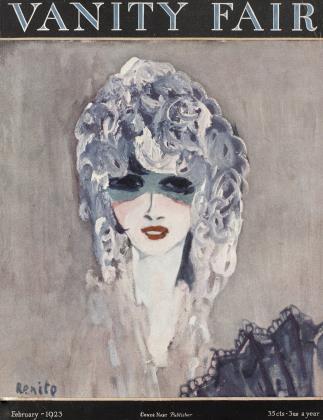Sign In to Your Account
Subscribers have complete access to the archive.
Sign In Not a Subscriber?Join NowThe Fashions and Pleasures of New York
JOHN McMULLIN
SAVOY and Brennan have sent out invitations to meet their friend "Margie" any night you care to drop over to Monte Carlo. Certainly no one would miss the opportunity, for there is nothing like this trio in the world. Sir Arthur Conan Doyle isn't in it when it comes to Bert Savoy's materialization of "Margie". No one who has seen Savoy and Brennan in the Greenwich Village Follies can deny that before they leave the stage they have been joined in the flesh by the far famed "Margie". Imagine a cabaret which is presided over by a hostess whose profession is female impersonation. New York night life is becoming more exotic every day. Uptown in East 57th Street an ex-Russian general of the Imperial guards is now the proprietor of the latest and most Russian of Russian restaurants. The decoration, the food and the liveries of the servants give the place real atmosphere. It has the distinction of being one of the few places in New York where one may go for supper and conversation instead of supper and jazz. It is considered very smart to dine there on Sunday night, judging by the number of beautiful ladies with large strings of pearls generously dotted about the room; the inconspicuous observer has no chance at all if he has not engaged a table in advance.
The voice of the intellectuals is every day more insistent in its demand for places where conversation is possible. The doubting manager has begun to believe them in earnest and so "The Eagle", the Russian restaurant I have described, has been followed by the "Club Gallant" in Washington Square. This cabaret is decorated in a fantastic Viennese manner. At one end of the room is a small stage on which each night is given a kaleidoscopic review, consisting of twelve artists, which takes place sharp at midnight and lasts only thirty minutes. The place has got quite a reputation for itself and is crowded with interesting people from the four corners of the town. Why is it that the far-away-place seems more exciting than the place just around the corner?
In the old days many such cafes and restaurants in Paris became famous because of the celebrities who frequented them. The famous artists, writers and theatrical personalities of a generation gone by were in the habit of going nowhere but to their favorite cafe. There they held court each day at their accustomed hour. Today every cafe and restaurant in New York is known because of the artist who presides over it. The place is theirs. When the theatre crowd disperses, it is to the haunt of their favorite that they go. The following of such people as Gilda Gray at the Rendezvous, Doraldina at Gypsy Land, Yvonne George at the Club Gallant, Bert Savoy at Monte Carlo and Paul Whiteman at the Palais Royal, is great enough to keep their names burning in electric lights far into the night.
A new volley of "musical fire-works" is just about to be shot off at the Plantation. The shower of stars will of course fall on Florence Mills' head. The term musical fireworks is very pat for this extraordinary negro review. It is whispered about town that one must sec this years' negro show at Daly's for it is supposed to be as good as last year's Shuffle Along. Of course the "fans" of Shuffle Along, who were a brilliant gallery, are loath to admit that anything could ever take its place, but the fact remains that the Wednesday midnight performance of Liza is becoming as smart as was the other's a year ago. So like the rest of the sheep, we shall join the throng and make our pilgrimage.
One of our foremost American artists, Norman Bell Geddes, has just done the new decorations at the Palais Royal. Needless to say they are well worth seeing. Since the opening night I have heard nothing but praise of his work. When the New Yorker is enthusiastic he is really impressed. Rain and Merton of the Movies have both impressed New York and that means they are also very good.
The manner in which the Rendezvous has lately been done is to the credit of Richard d'Asir. A new artist to this country, Boris Artzybasheff is responsible for the fantastic murals at the Eagle. All this is quite as it should be. Good artists should be used commercially. And this idea has been more nearly achieved in America than in any other country. Abroad the work of such artists as Bakst and Sert is seen in the picture galleries and on the stage, but practically never in the world of commerce. Few people realize this fact. But it is important to the artist for here he may earn his living, while in Europe he often has to rely on a patron. The stage here has accepted Jones. Geddes, Locher, Simonson and the others, so that if they cared to, they could commercialize their work in the theatre. Our magazines employ the best artists they can afford. And photography has become as distinguished a profession as portrait painting, due to the American magazine editor.
 View Full Issue
View Full Issue












Subscribers have complete access to the archive.
Sign In Not a Subscriber?Join Now